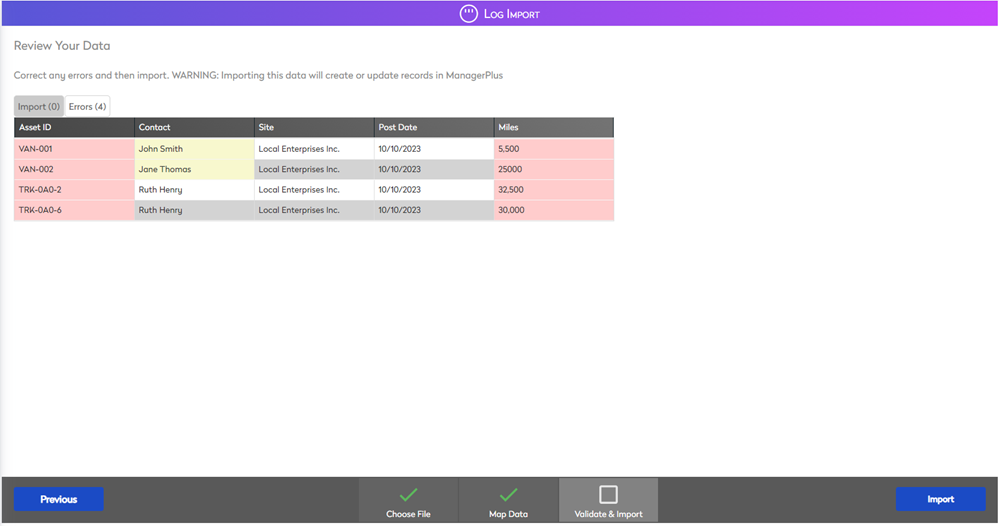Import your Logs and Meter Readings
Level: Administrator
The Logs and Meter Readings Import is used to import meter readings, gauges, trip distance, and fluid levels.
Step 1. Download our sample file
- Navigate to Settings.
- From Tools and Support, click the Import
 icon. The Import Tool dialog displays.
icon. The Import Tool dialog displays. - Click Logs & Meter Readings.The Log Import Screen displays.

- Click on Sample-Log-File.Csv to download the sample import template.
Step 2. Complete the sample file
- Open the Sample-Log-File.csv file in Microsoft Excel.
- Remember the data in this file is a sample; you must delete these rows as you do not want to import these in.

- Under each of the Column Headers, complete the row data. For details on the data, see Log Import Template Data.
- After all the data has been entered on the sheet, save the file to your computer.
Step 3. Upload the completed sample file
- From the Select a Site drop-down, click on the arrow to display the drop-down menu. Select which site to import the logs to.
- Click the Choose File button.
- Navigate to the file and select it. The file name displays in the screen.
- If you want to use an import definition, then from the Select an Import Definition drop-down, select a definition.
Import Definitions
When you upload your meter readings in bulk, your file may not have the meter readings for every asset or log type. This depends on where your assets are located, or based on your meter reading routine (weekly/biweekly etc.). You can use the saved Import Definitions as a preset when uploading meter readings so the appropriate columns are mapped automatically.
Create Import Definition
When you map a log import and this contains the import definitions you want, then you can save the definition.
- In the Save Import Definition field, enter a name.
- Click the Save button and you will be able to use this import definition for future imports.

- Click the Map Data button. The import fields displays.
Step 4. Map the data
The Map Data table shows which fields from the import file are being mapped to the fields in the application. Use the Map Data table to align the correct fields from the import file to the application. In this example, Status is mapped to Serial, which needs to be corrected.
- Verify that all ManagerPlus Fields are matched with the correct Import File Fields.

- Click the Preview button. The Review Your Data screen displays.
Step 5. Validate and import
Use the Import and Errors tabs to validate and review your data before importing.
- The import tab displays successful line items.
If you find a discrepancy, click on the incorrect import field and the drop-down arrow displays. Then you can click the arrow to select the field to map to.
- Click on the Errors tab. The line items with errors display. All records can be edited before importing.
- Review all the data in the import tab and correct any errors. Drag the scroll bar from left to right in the bottom row to view all the mapped fields.
Fields highlighted in:
- Red - Indicates that a required field is missing information and must be filled in. Click in the field and complete the data.
- Yellow - Indicates that the entered asset type does not exist but will be created upon importing.
- Click the Preview button. The Review Your Data screen displays.
Step 5. Validate and import
Use the Import and Errors tabs to validate and review your data before importing.
- The import tab displays successful line items.
- Click on the Errors tab. The line items with errors display. All records can be edited before importing.
- Review all the data in the import tab and correct any errors. Drag the scroll bar from left to right in the bottom row to view all the mapped fields.

Fields highlighted in:
- Red, such as Budget Group, indicates that a required field is missing information and must be filled in.
- Yellow, such as Asset Type, indicates that the entered asset type does not exist but will be created upon importing.
- Now you are ready to import, click on the Import button. The log data is imported and available in the Assets module.

